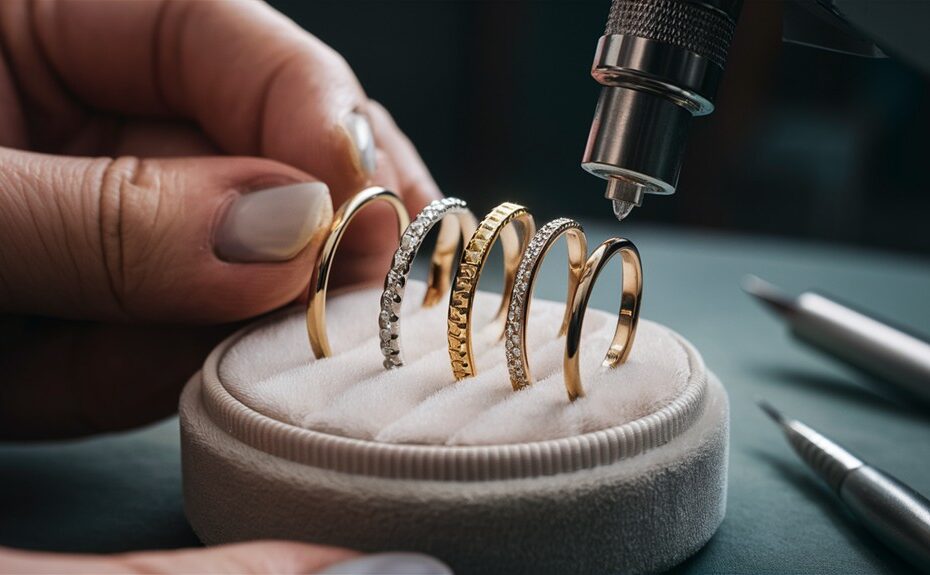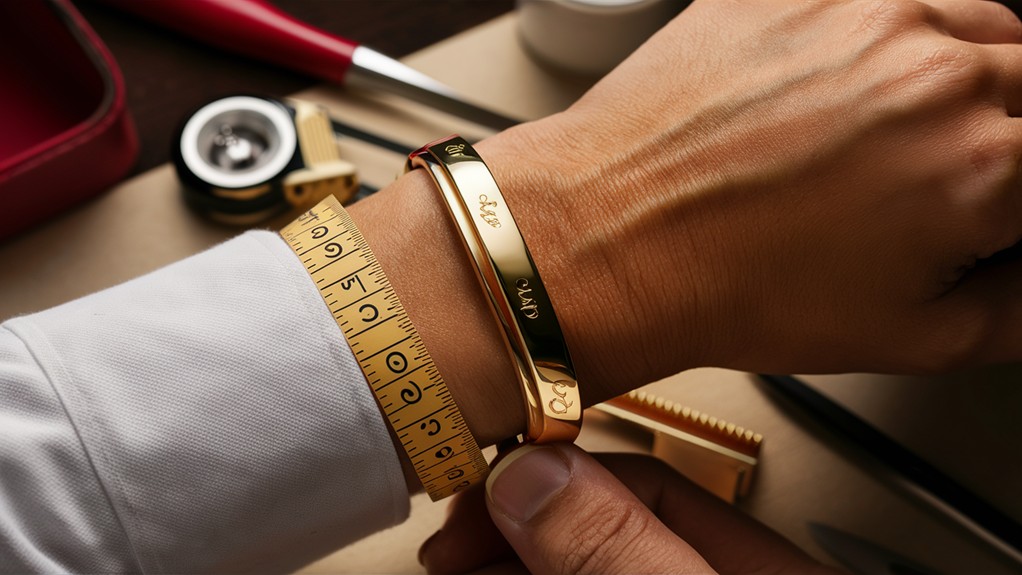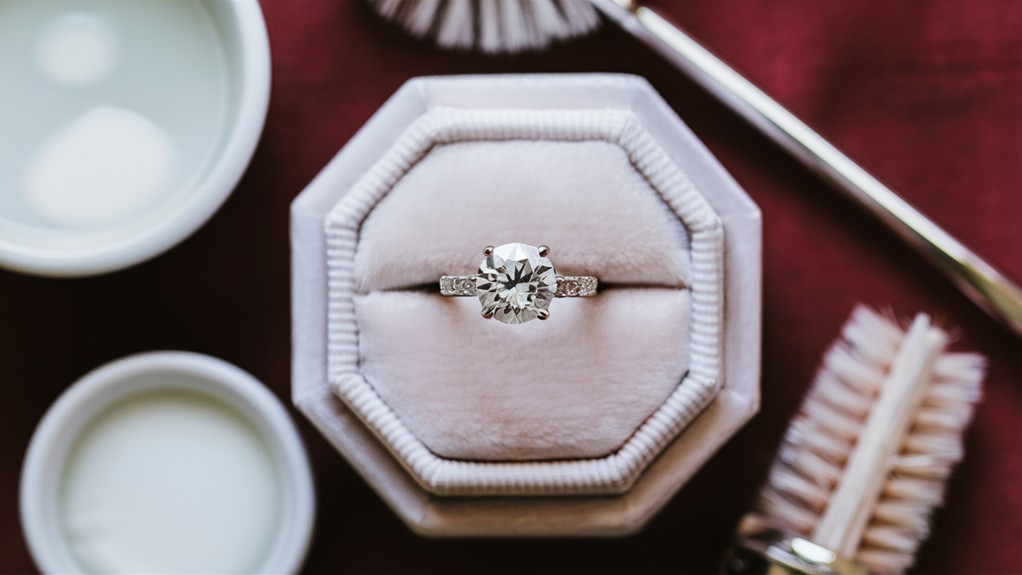When you're considering a wedding or engagement ring, you might be drawn to the delicate beauty of thin bands. But have you ever wondered about their durability? 5mm ring bands offer a sweet spot between elegance and strength, but they're just one option in a sea of choices. As you begin this significant purchase, it's vital to understand how band width affects not only aesthetics but also longevity and practicality. What factors should you weigh when deciding on ring thickness? And how can you guarantee your cherished symbol of love stands the test of time? Let's investigate the world of thin rings and uncover the secrets to making an informed decision.
Our Highlighted Points
- 5mm ring bands offer superior durability compared to thinner options, withstanding daily wear and reducing the risk of bending or damage.
- Thicker bands provide better support for larger stones and intricate designs, enhancing overall stability and longevity.
- 5mm rings allow for more resizing options in the future, accommodating potential changes in finger size over time.
- While less delicate in appearance, 5mm bands can still be designed with elegant aesthetics and are suitable for various lifestyles.
- Choosing a 5mm ring band often results in lower maintenance requirements and less frequent repairs compared to thinner alternatives.
Understanding 1.5mm Ring Bands
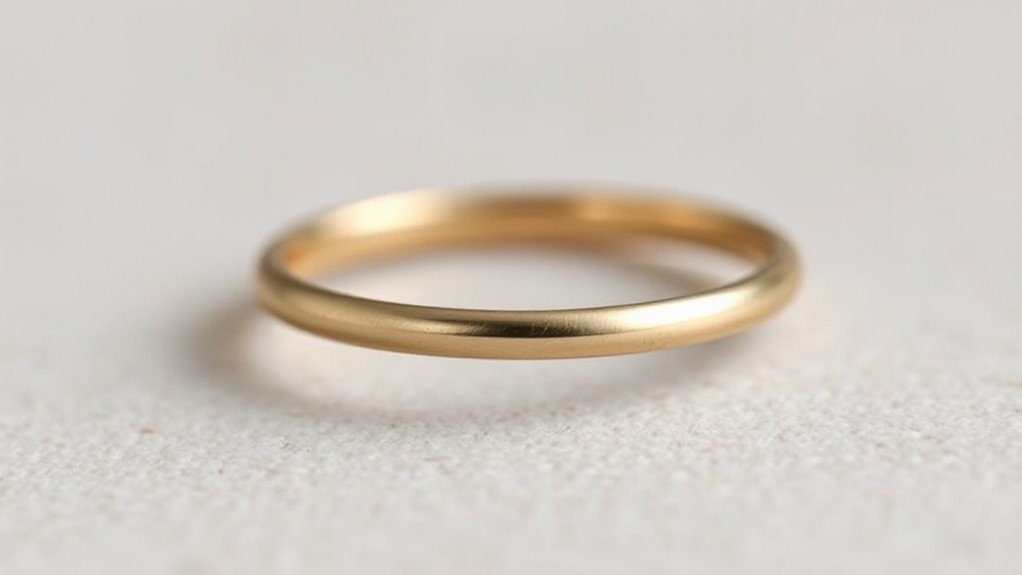
A 1.5mm ring band sits on the thinner end of the spectrum, offering a delicate appearance that appeals to some but raises concerns for others.
When considering 1.5mm ring bands for engagement rings or wedding bands, it's essential to understand their characteristics and potential limitations:
- Delicate Appearance: These thin bands can create a subtle, elegant look, especially on smaller fingers.
- Durability Concerns: The slender profile may compromise structural integrity, making them more susceptible to wear and tear over time.
- Stone Support: Larger stones may not be adequately supported by 1.5mm bands, potentially leading to instability or loss.
- Resizing Limitations: Thin bands offer fewer resizing options, which can be problematic for future adjustments.
- User Experiences: While some wearers are satisfied, others report concerns about long-term durability and comfort.
When choosing between 1.5mm and wider 5mm ring bands, consider your lifestyle, finger size, and desired stone size.
For improved durability and stone support, jewelers often recommend a minimum thickness of 1.7-1.8mm.
If you're set on a thinner band, be prepared for potential maintenance issues and limited resizing options in the future.
Durability Factors for Thin Rings
When considering thin rings, especially those in the 1.5mm to 2mm range, durability becomes a key concern. Thin bands, while aesthetically pleasing, are more susceptible to bending, cracking, and losing shape over time.
To improve the longevity of your wedding or engagement ring, it's essential to understand the factors affecting its durability: When to remove your ring is crucial in maintaining its longevity. For example, it’s best to remove your ring when doing activities that may put it at risk of damage, such as playing sports or doing heavy lifting. Additionally, removing your ring when applying lotions, perfumes, or cleaning chemicals can prevent buildup and preserve its shine.
- Band width: A minimum thickness of 2mm is recommended for thin rings to boost structural integrity.
- Metal choice: Opt for harder metals like gold, which maintain shape better than softer alternatives such as platinum.
- Design complexity: Intricate designs or smaller prongs on thin bands may increase the risk of losing accent stones because of reduced support.
To optimize the lifespan of your thin ring:
- Choose a band width of at least 2mm for better durability
- Select harder metals for greater resistance to wear and tear
- Avoid overly complex designs that may compromise structural integrity
- Schedule regular professional inspections and cleanings
Pros of Skinny Engagement Rings

Elegance and versatility define skinny engagement rings, making them a popular choice for modern brides. These thin bands, typically measuring 2mm wide or less, offer several advantages:
- Improved center stone appearance: The delicate profile of skinny engagement rings emphasizes the center stone, creating a stunning visual impact.
- Affordability: Thin bands often use less metal, resulting in more affordable designs compared to wider alternatives.
- Stackability: Skinny rings pair seamlessly with wedding bands or anniversary rings, allowing for personalized combinations without overwhelming your finger.
- Minimalist appeal: The simplicity of thin bands caters to minimalist preferences, offering a classic and timeless aesthetic.
- Durability: In spite of their slender profile, high-quality skinny engagement rings can maintain durability for everyday wear when crafted with a thickness between 1.6mm and 2.0mm.
When selecting a skinny engagement ring, consider:
- Opting for pave settings to add sparkle without compromising the band's delicate appearance.
- Choosing a band width that complements your center stone size.
- Ensuring the ring's thickness meets the minimum requirements for durability.
Cons of Delicate Wedding Bands
In spite of their aesthetic appeal, delicate wedding bands come with several drawbacks you should consider before making your choice. Thin bands, typically measuring 1.5mm to 2mm, are more susceptible to bending and losing shape over time, especially with everyday wear.
This vulnerability can lead to structural issues, compromising the ring's durability and longevity. Furthermore, the delicate nature of these bands limits resizing options, which may pose challenges if your finger size changes in the future.
When it comes to engagement rings with accent stones, thin bands may not provide adequate protection because of smaller prongs, increasing the risk of stone loss during regular activities.
Maintenance requirements for delicate wedding bands are likewise more demanding, necessitating frequent professional care to maintain their structural integrity.
Consider these cons before opting for a thin band:
- Increased susceptibility to bending and shape loss
- Higher risk of cracking or weakening, especially for active lifestyles
- Limited resizing options for future adjustments
- Inadequate protection for accent stones
- More frequent maintenance requirements
While thin bands offer a sleek and elegant appearance, it's vital to weigh these drawbacks against their aesthetic benefits.
Carefully evaluate your lifestyle and long-term preferences to determine if a delicate wedding band is the right choice for you.
Maintenance Tips for Thin Rings
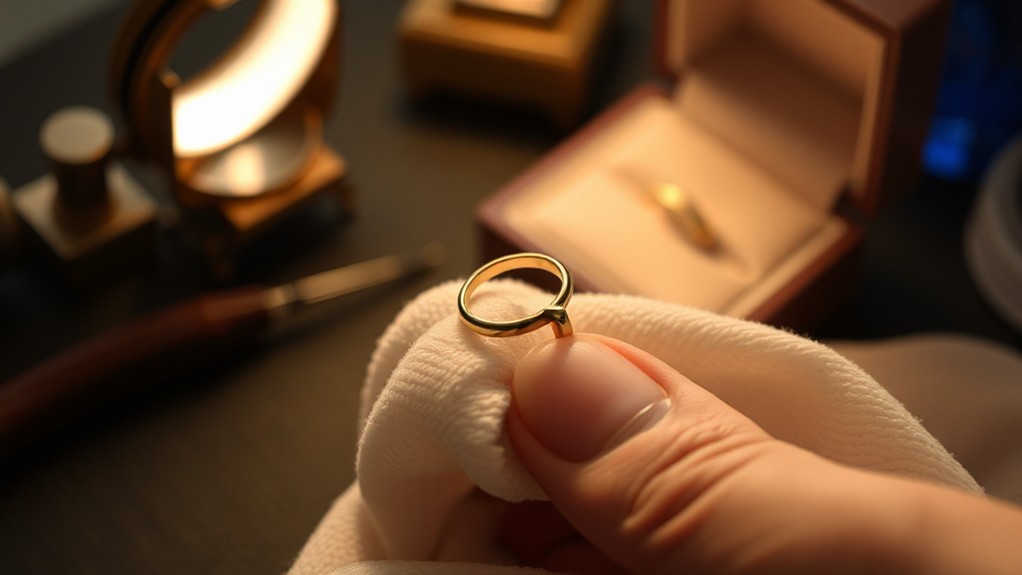
To maintain the beauty and integrity of thin rings, you'll need to adopt a diligent care routine. Regularly inspect your thin bands for signs of bending or damage, as their delicate nature makes them more susceptible to wear and tear over time. This is particularly crucial for engagement rings and wedding rings that are worn daily.
To minimize the risk of damage:
- Avoid wearing thin bands during strenuous activities, such as exercise or manual labor.
- Clean thin rings frequently using a mild soap solution and a soft brush to prevent dirt buildup.
- Consider professional maintenance every six months to a year for thorough inspections and necessary repairs.
- Store thin rings separately in a soft pouch or lined box to prevent scratching or rubbing against other jewelry.
Choosing the Right Metal
While proper maintenance is key to preserving thin rings, selecting the right metal is likewise important for their longevity. When choosing a metal for thin bands, consider durability, appearance, and metal thickness.
For engagement rings and wedding rings with narrow profiles, 14k gold often provides an optimal balance of strength and aesthetic appeal. It's more resistant to scratching and bending than 18k gold, making it suitable for daily wear.
- 14k gold: Durable and maintains shape well
- Platinum: Dense but soft, prone to bending
- Stainless steel: Highly durable, resistant to scratching
- Silver: Not recommended because of softness and tarnishing
- 18k gold: Less durable than 14k, but more lustrous
If you're considering platinum for thin bands, be aware that its softness may lead to more frequent reshaping.
Stainless steel offers exceptional durability for thin rings but lacks the traditional precious metal look. When selecting a metal, confirm a minimum thickness of 1.7mm for structural integrity.
Lifestyle Considerations for Band Width

Choosing the right band width isn't just about aesthetics—it's crucial to take into account your lifestyle when selecting a 5mm ring band. If you lead an active lifestyle or have a hands-on job, you'll want to prioritize durability and stability in your engagement ring or wedding band.
Consider the following factors when selecting your band width:
| Lifestyle | Recommended Width | Considerations |
|---|---|---|
| Active | 2.0mm – 3.5mm | Improved durability, less maintenance |
| Moderate | 1.6mm – 2.0mm | Balance of style and stability |
| Sedentary | 1.5mm – 2.0mm | Delicate aesthetic, more maintenance |
For those with active lifestyles, opt for bands between 2.0mm and 3.5mm to guarantee longevity and reduce the risk of damage. Thinner bands, while visually appealing, may struggle to support larger stones and are more susceptible to bending. If you're set on a thinner band, be prepared for more frequent maintenance and care.
Alternative Designs for Durability
Innovative designs offer solutions for those who love the look of thin bands but need better durability.
When considering alternative designs for your engagement rings, you'll find options that balance aesthetics with longevity. Cathedral settings, for instance, provide extra support for thin bands while maintaining a delicate appearance.
You can additionally opt for a tapered band design, which offers a thinner look at the top and a sturdier base.
Consider these alternative designs for improved durability:
- Thicker shank with thinner accents
- Protective metal bezels around accent diamonds
- Reinforced prongs
- Wider base customization
- Cathedral settings for added support
Frequently Asked Questions
Is 1.5 Mm Band Too Thin for Engagement Ring?
Yes, a 1.5 mm band is generally too thin for an engagement ring. You'll likely face durability issues and potential stone instability. It's best to opt for at least a 2 mm band for better longevity and support.
Is 1.8 Mm Too Thin for a Wedding Band?
Yes, 1.8 mm is generally considered too thin for a wedding band. While it's stylish, you'll face durability issues with daily wear. You're better off choosing a band at least 2 mm thick for longevity and comfort.
Is 1.6 Mm Too Thin for Wedding Band?
Yes, 1.6 mm is generally considered too thin for a wedding band. You'll likely face durability issues and potential deformation over time. It's best to opt for at least 1.7-1.8 mm to guarantee your ring's longevity and stability.
Will a 1mm Ring Break?
A 1mm ring is likely to break. You'll find it's extremely delicate and prone to bending or losing shape. It won't withstand daily wear well and may not support larger stones. Consider a thicker band for durability.
